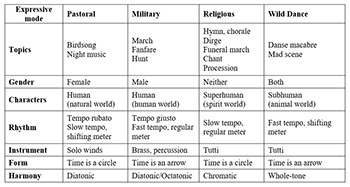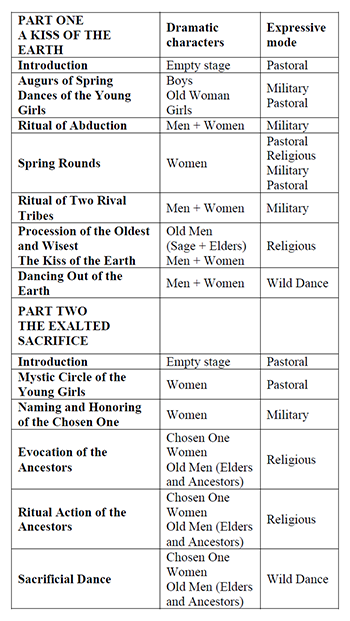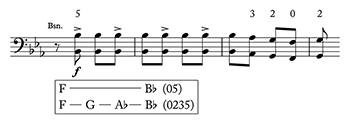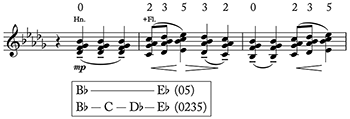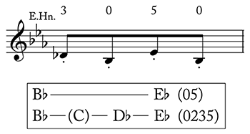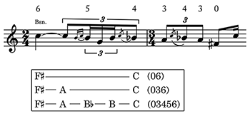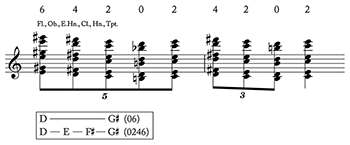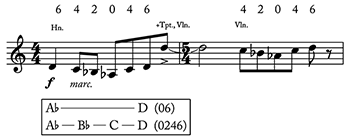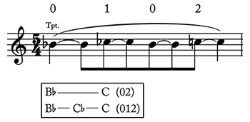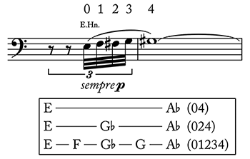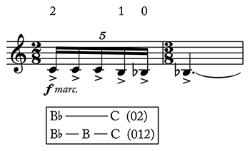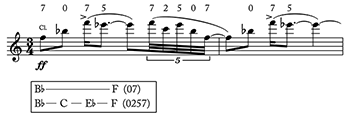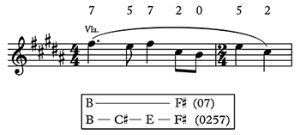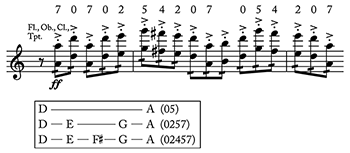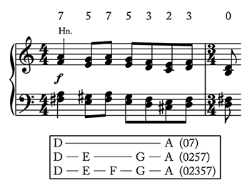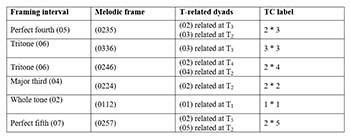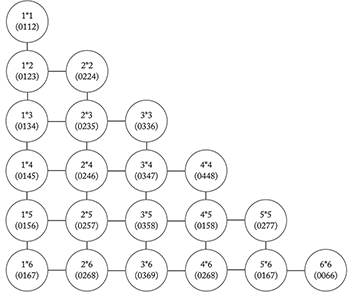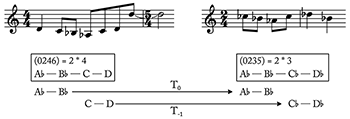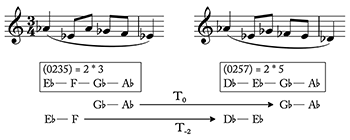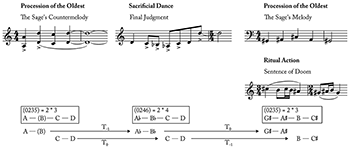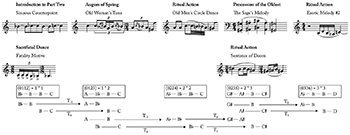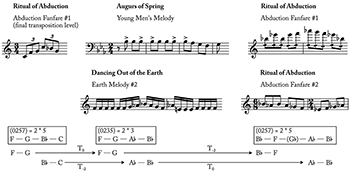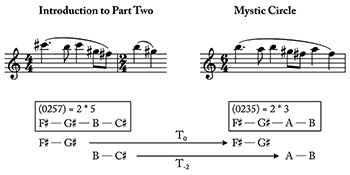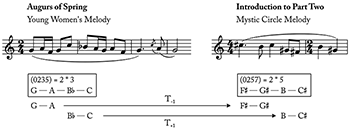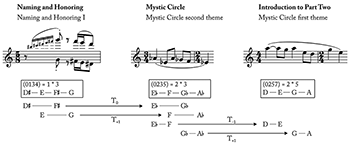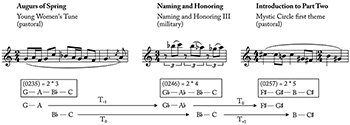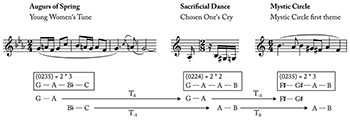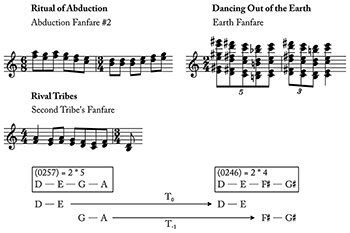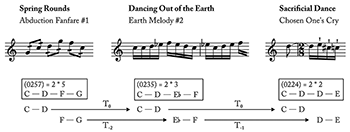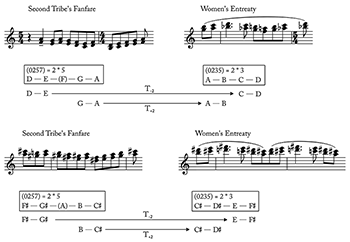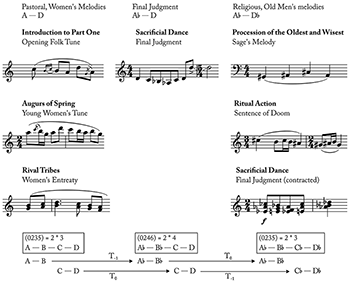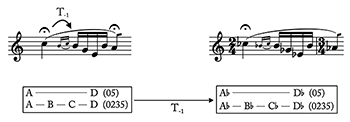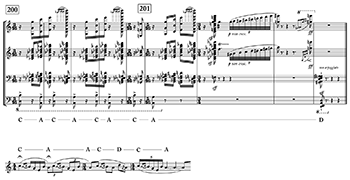EXAMPLE TESTING
Example 1. Four expressive modes, with associated musical topics, dramatic features, and musical characteristics
(click to enlarge)
Example 2. The scenes of the ballet in relation to dramatic characters and expressive modes
(click to enlarge)
Example 3. The Melody of the Young Men, as they learn divination from the Old Woman
(click to enlarge)
Example 4. The Spring Rounds Procession
(click to enlarge)
Example 5. The Women’s Entreaty, as they try to intercede in the warlike games among the men
(click to enlarge)
Example 6. The Earth Melody, part of a wild, orgiastic dance for male and female dancers (Dancing Out of the Earth, Reh. 75)
(click to enlarge)
Example 7. Mystic Circle Second Theme
(click to enlarge)
Example 8. The Sentence of Doom, heard as the tribal Ancestors and Elders pass their final, fatal judgment on the Chosen One
(click to enlarge)
Example 9. The Opening Folk Tune is the only actual folk melody in the ballet that is complete and presented in something like its original form
(click to enlarge)
Example 10. The Young Women’s Melody marks their entrance onstage and accompanies their first dance
(click to enlarge)
Example 11. The Earth Melody (variant), now in chattering sixteenth notes
(click to enlarge)
Example 12. Nature Melody #3 is one of a number of melodies designed to represent sounds of nature, including ancient shepherd’s reed pipes called “dudki.”
(click to enlarge)
Example 13. The four-note Motto Ostinato that runs through the entire Augurs of Spring
(click to enlarge)
Example 14. The Sage’s Melody represents The Sage and the tribal Elders from the first moment they come onstage
(click to enlarge)
Example 15. In the opening measures of the ballet, just after the Opening Folk Tune, we hear a brief premonition of the Old Woman’s Melody (Introduction to Part One, Reh. 1)
(click to enlarge)
Example 16. A bit later in the Introduction to Part One, still before any dancers have come onstage, there is a more extended preview of the Old Woman’s Melody
(click to enlarge)
Example 17. When the Old Woman does arrive onstage, at the beginning of Augurs of Spring, we hear her melody in its definitive form
(click to enlarge)
Example 18. Exotic Melody #2—chromatic, snaky, serpentine—is one of three such tunes with which the Ancestors and Elders seek to mesmerize and immobilize the Chosen One
(click to enlarge)
Example 19. The Earth Fanfare is part of a wild, orgiastic dance of life
(click to enlarge)
Example 20. The theme of Final Judgment, representing an implacable fate
(click to enlarge)
Example 21. This short melody is part of a mysterious Sinuous Counterpoint
(click to enlarge)
Example 22. Exotic Melody #1 moves in a similarly sinuous and chromatic way within its (024) frame
(click to enlarge)
Example 23. This Circle Dance for Old Men is another chromatic melody used by the Elders and Ancestors as they circle their victim, but this one is more aggressive than charming
(click to enlarge)
Example 24. This is The Chosen One’s Cry—her principal tune as she enacts her dance of death
(click to enlarge)
Example 25. The Fatality Motive represents an implacable fate
(click to enlarge)
Example 26. Nature Melody #1 is the first of several melodies in the Introduction to Part One that represent the sounds of the natural world
(click to enlarge)
Example 27. In Nature Melody #4, the shepherd’s pipes are now evoked by a solo oboe
(click to enlarge)
Example 28. In another nature melody from the Introduction to Part One,
(click to enlarge)
Example 29. The Mystic Circle Melody has a natural, sweet, unforced quality
(click to enlarge)
Example 30. Abduction Fanfare #1 is violent, martial music that represents the men seizing the women in an orgy of sexual violence
(click to enlarge)
Example 31. Abduction Fanfare #2 is a musical celebration of male sexual violence
(click to enlarge)
Example 32. Abduction Fanfare #2 returns in a later scene, as the music for the second of the Two Rival Tribes
(click to enlarge)
Example 33. The TC property in the Rite’s principal melodic frames
(click to enlarge)
Example 34. The TC property in three additional rarely used melodic frames
(click to enlarge)
Example 35. Voice-leading space for tetrachordal set classes with the TC property
(click to enlarge)
Example 36. Two versions of the Final Judgment melody, representing (0246) and (0235)
(click to enlarge)
Example 37. Two versions of the Mystic Circle Second Theme, representing (0235) and (0257)
(click to enlarge)
Example 38. A network of melodies associated with the Sage and the other Old Men
(click to enlarge)
Example 39. A voice-leading network that further connects melodies associated with the Sage and other Old Men, and links them with the Old Woman
(click to enlarge)
Example 40. A voice-leading network that connects melodies associated with the Young Men, with male violence, and with the military expressive mode
(click to enlarge)
Example 41. The two Mystic Circle melodies (first theme and second theme)
(click to enlarge)
Example 42. A larger transposition up by whole tone (T2) is achieved in stages, as each whole tone within the melody moves independently
(click to enlarge)
Example 43. A large-scale motivic contraction connects statements of the Mystic Circle First Theme
(click to enlarge)
Example 44. Two melodies associated with Young Women and exemplifying the feminized pastoral mode
(click to enlarge)
Example 45. The Amazonian principal theme of The Naming and Honoring of the Chosen One maintains the connection with Young Women, but transforms the expressive mode from pastoral to military
(click to enlarge)
Example 46. Another Amazonian, military theme from The Naming and Honoring of the Chosen One is also part of the women-centered network
(click to enlarge)
Example 47. Linkage of the Old Woman’s Tune, Exotic Melody #3 (which Craft calls “snake charming”), and the Chosen One’s Cry
(click to enlarge)
Example 48. Different musical characterizations of the female
(click to enlarge)
Example 49. The Earth Fanfare in relation to Abduction Fanfare #2 and the Second Tribe’s Fanfare
(click to enlarge)
Example 50. A different melody from Dancing Out of the Earth also has fanfare qualities, and is linked via TC voice leading with other fanfare melodies in the ballet
(click to enlarge)
Example 51. The Women’s Entreaty as a compression of the Second Tribe’s Fanfare
(click to enlarge)
Example 52. A basic opposition between feminine, pastoral melodies within A-D and ponderous, religious processions for Old Men within
(click to enlarge)
Example 53. The transposition of the Opening Folk Tune from A-D to
(click to enlarge)
Example 54. The final measures of the ballet recall and demonically parody the Opening Folk Tune, especially the emphasis on the interval A-C within the A-B-C-D frame
(click to enlarge)
